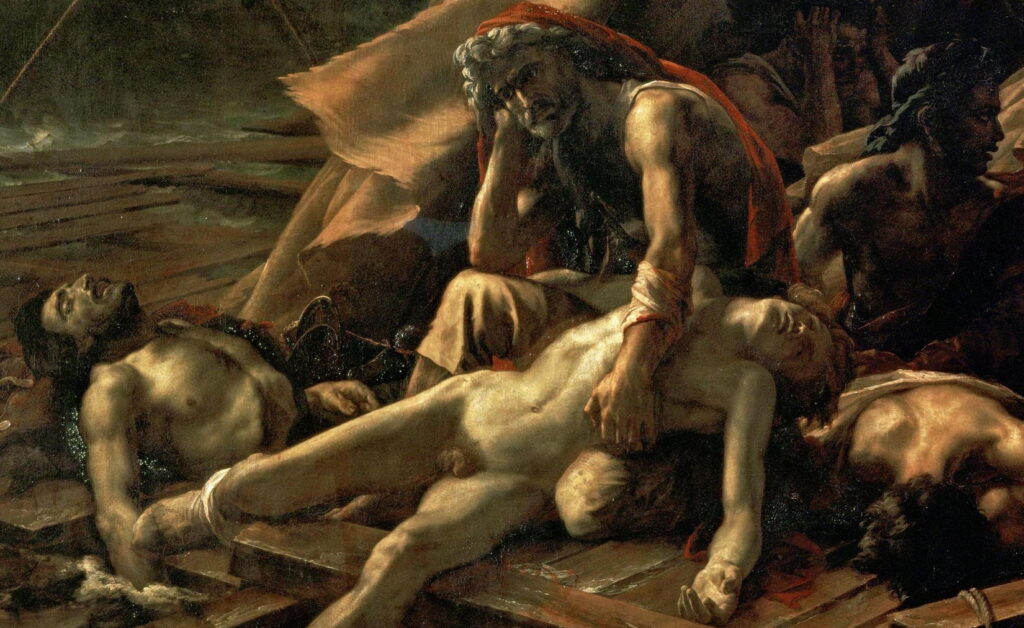Commemorating the Death of Théodore Géricault: 1 Foundation

Narrative or history painting had long been the queen of the genres, but by the end of the eighteenth century attempts were being made to draw it away from its longstanding obsession with ancient Greeks and Romans. If there’s one work that transformed history painting it’s Théodore Géricault’s controversial depiction of a maritime disaster that occurred off the coast of West Africa in 1816. The Raft of the Medusa now overwhelms its room in the Louvre with its life-size figures of shipwreck survivors. Within five years of completing it, on 26 January 1824, its artist was dead. This short series commemorates the bicentenary of Géricault’s untimely death.
Jean Louis Théodore Géricault was born to an upper-middle class family in Rouen, France, but when he was four years old they moved to Paris for his father to work in the tobacco trade. He showed an early aptitude for drawing, and was taught at school by a former winner of the coveted Prix de Rome for history painting. When he was seventeen, Géricault started his training in the studio of Carle Vernet, who at that time was the leading equestrian painter in France.
Théodore Géricault (1791–1824), Two Horses (c 1808), oil on canvas, 10.3 x 16 cm, The Phillips Collection, Washington, DC. Wikimedia Commons.
His early painting of Two Horses from about 1808 demonstrates his rapidly developing skills, and the start of his obsession with horses that was eventually to contribute to his early death.
Two years later, Géricault moved on to the studio of Pierre-Narcisse Guérin, an academic painter who was later to teach Eugène Delacroix. While recognising his pupil’s talent, Guérin proved a fierce critic. Early in 1811, Géricault enrolled as a student at the École des Beaux-Arts, while continuing his training in Guérin’s studio.
Théodore Géricault (1791–1824), The Charging Chasseur (1812), oil on canvas, 349 x 266 cm, Musée du Louvre, Paris. Wikimedia Commons.
In 1812, Géricault submitted his first painting to the Salon. The Charging Chasseur (1812) was not only accepted, but attained such critical acclaim that he was awarded a gold medal, and his future appeared bright. It’s rich with fine detail in the metalwork of the horse’s headstall, and the chasseur’s tunic.
Théodore Géricault (1791–1824), The Wounded Cuirassier Leaving the Field of Battle (1814), oil on canvas, 358 x 294 cm, Musée du Louvre, Paris. Image by Shonagon, via Wikimedia Commons.
He followed that up with The Wounded Cuirassier Leaving the Field of Battle (1814), which must have been influenced by the artist’s service as a musketeer that year, until his resignation shortly before his regiment was disbanded at the end of 1815. This was less well-received at the Salon, and he returned to his studies, where his entry for the Prix de Rome was unsuccessful.
In 1816, he left Paris to visit Florence and travelled on to Rome.
Théodore Géricault (1791–1824), Race of the Barberi Horses (1817), oil on paper mounted on canvas, 44.5 x 59.5 cm, Walters Art Museum, Baltimore, MD. Wikimedia Commons.
In February 1817, Géricault witnessed the Roman Carnival, with its traditional horse race. Among the studies that he made of that event is Race of the Barberi Horses (1817), intended for a later large studio painting that he never started. This was a longstanding tradition of the Roman Carnival, where these horses were gathered in the Piazza del Popolo, then raced without riders to gallop down the Corso to be recaptured at the finish. The Barberi are a hardy North African breed popular among the Berbers, and are still bred today although this race has long since ceased.
He went on to visit Naples, then returned to Paris via Siena, Florence and Switzerland. He painted a few landscapes, but was searching for the theme of a large history painting intended for the Salon in 1819.
By 1816, France was a nation in turmoil. Crushed militarily at the Battle of Waterloo the previous year, Napoleon’s empire had collapsed, and the rest of Europe had restored the rule of Louis XVIII, reverted the country’s boundaries to those of 1789, and were occupying the country until it paid a war indemnity.
In June 1816, the French Naval frigate Méduse (Medusa) sailed as the leader of a small group to accept the return of French Senegal from the British, as part of the peace process. She was under the command of Viscount de Chaumereys, who had had little experience at sea over the previous twenty years, but had been preferred as a result of political policy.
The Méduse overtook the other ships instead of sailing in company, and the captain’s poor navigation took it more than a hundred miles off course, to run aground on a sandbank off the coast of West Africa on 2 July. The decision to abandon the vessel was taken on 5 July, but with four hundred souls on board and capacity for only around 250 in the ship’s boats, at least 146 men and one woman were put on board an improvised raft built hastily for the purpose.
Although the ship’s boats had originally intended to tow the overloaded and partially submerged raft, it was cut loose after only a few miles. The survivors on the raft then had little to keep them alive: a bag of ship’s biscuits that were eaten on the first day, two barrels of water that were soon lost overboard, and six of wine, hardly suitable to prevent dehydration. Over the following thirteen days, most died or were killed, leaving just fifteen alive when they were spotted by the Argus, a brig from the same group bound for Senegal.
Some of the survivors wrote a detailed account which was published in 1817, and deepened the embarrassment caused to the newly-restored French monarchy. What should have been a routine step in restoring a French colony became a lasting matter of shame in the press, and angry public debate.
In the winter of 1817-18, when Géricault must have decided to paint this disaster, he would have recognised the two changes of fortune (moments of peripeteia) in the story: the abandonment of the Méduse, and the rescue of its few survivors remaining in the raft. Classically, the best depictions of shipwreck and rescue have chosen the latter, as it shows both the results of the gruelling period of survival and the imminent hope of being saved. Géricault may also have considered this a parallel with that moment in the history of France.
During the spring and summer of 1818, Géricault worked on accumulating the information which he needed for the painting. He spent a long time talking to survivors, notably Savigny and Corréard, principal authors of the book about the incident, and studied popular lithographs that were being produced to illustrate it. Of the three example illustrations included in Eitner’s monograph about this painting (References below), one showed the abandonment, one a mutiny on board the raft, and the last the sighting of the rescue ship.
Jean Louis Théodore Géricault (1791–1824), Sketch for The Raft of the Medusa, Survivors Hailing a Rowing Boat (undated), ink on paper, 24 x 33 cm, Musée du Louvre, Paris. Wikimedia Commons.
He sketched various moments during the disaster, gradually honing in on the moment of rescue. This drawing shows one of the ship’s boats from the Argus reaching the raft, for example, and Géricault drew each event from the mutiny through to the raft being left empty once everyone had been rescued. Note that in this sketch, the raft is shown as a long rectangle rather than a square.
Jean Louis Théodore Géricault (1791–1824), Sketch for The Raft of the Medusa (undated), pencil, pen and sepia on paper, 41 x 55 cm, Musée du Louvre, Paris. Wikimedia Commons.
Once he had selected the second moment of peripeteia, when the survivors first sighted the Argus, he then worked through different compositional options, resulting in his initial compositional study in oils below.
Jean Louis Théodore Géricault (1791–1824), Study for The Raft of the Medusa (1819), oil on canvas, 36 x 48 cm, Musée du Louvre, Paris. Wikimedia Commons.
He continued to develop from this, probably completing these preparations during the autumn of 1818.
In this period of almost a year devoted to preparatory work, Géricault accumulated a great deal of information about the disaster. He had enlisted the help of another of the survivors, a carpenter, in constructing props for his studio painting. As figures resolved for inclusion in the work, he made detailed studies of those elements in readiness for painting.
Jean Louis Théodore Géricault (1791–1824), Study for the ‘father’ figure in The Raft of the Medusa (1819), black chalk and pencil on paper, 24.4 x 34 cm, Private collection. Wikimedia Commons.
This study shows one of the figures, known as “the Father”, from the group named “the Father holding his dead son”, seen below in the finished painting.
Jean Louis Théodore Géricault (1791–1824), The Raft of the Medusa (detail) (1818-19), oil on canvas, 491 x 716 cm, Musée du Louvre, Paris. Wikimedia Commons.
Géricault visited morgues to make studies of cadavers and body parts. When he came to paint individual figures, he carefully selected some of sickly appearance, including the young artist Eugène Delacroix, who was ill with jaundice at the time.
Jean Louis Théodore Géricault (1791–1824), The Raft of the Medusa (detail) (1818-19), oil on canvas, 491 x 716 cm, Musée du Louvre, Paris. Wikimedia Commons.
In contrast to his previous studies, though, for the finished work he decided to make the Argus so tiny that this most important element in the whole composition was also its smallest.
References
Athanassoglou-Kallmyer N (2010) Théodore Géricault, Phaidon Press. ISBN 978 0 7148 4400 8.
Eitner L (1972) Géricault’s Raft of the Medusa, Phaidon Press.



